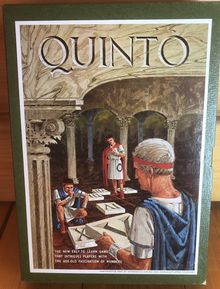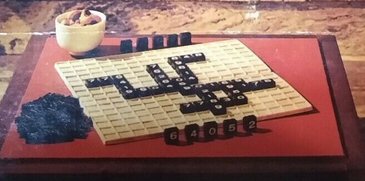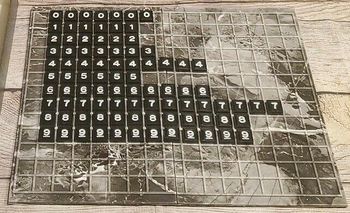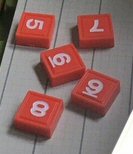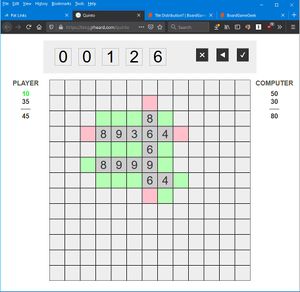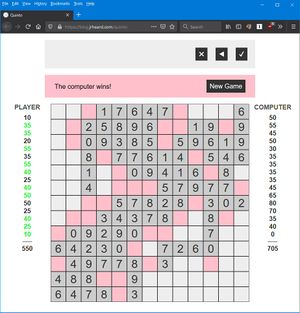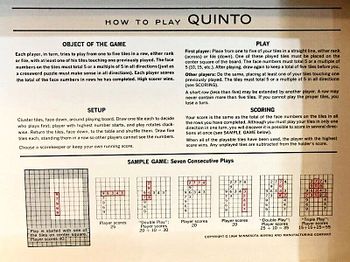Quinto (grid game): Difference between revisions
imported>Pat Palmer |
imported>Pat Palmer |
||
| Line 58: | Line 58: | ||
{{Image|Quinto in browser.jpg|right|300px|A completed game of Quinto from J. R. Heard's 2018 [https://blog.jrheard.com/quinto online version of Quinto]; here is [https://blog.jrheard.com/quinto-resurrecting-an-abandoned-board-game how to play]}} | {{Image|Quinto in browser.jpg|right|300px|A completed game of Quinto from J. R. Heard's 2018 [https://blog.jrheard.com/quinto online version of Quinto]; here is [https://blog.jrheard.com/quinto-resurrecting-an-abandoned-board-game how to play]}} | ||
In 2018, programmer [https://blog.jrheard.com/ J. R. Heard] created an addictive [https://blog.jrheard.com/quinto online version of Quinto]. | Since 2018, there has been an online version of Quinto<ref> | ||
In 2018, programmer [https://blog.jrheard.com/ J. R. Heard] created an addictive [https://blog.jrheard.com/quinto online version of Quinto]; last access 11/14/2020</ref>. It's programmer provided the computer with an "AI opponent" that is virtually unbeatable by humans, but also play hints that help humans increase their skills. The online game uses the 90-tile numerical distribution of the 1964 plastic-tile edition of the Quinto board game, but its board has four fewer vertical columns, making it a 13x13 grid. The game is powered by [[Javascript]], which means it executes locally in your web browser and the game web page can be saved locally on your computer for offline use. The game rules and [https://blog.jrheard.com/quinto-resurrecting-an-abandoned-board-game details about the source code] are also online. | |||
NOTE 1: <small>When I first tried playing the online game, the AI opponent beat me badly. I could "win" about a third of the time by giving myself a 250-point handicap. As my play experience improved, I have reduced my handicap to 125 points. Which just means, about a third of the time, I can come within 125 points of actually winning the game against the computer. The computer is so tough to beat because it can quickly do an exhaustive search of every possible move and select the move which yields the most possible points. For a human to do this requires a lot of time (and is error prone).</small> [[User:Pat Palmer|Pat Palmer]] ([[User talk:Pat Palmer|talk]]) | NOTE 1: <small>When I first tried playing the online game, the AI opponent beat me badly. I could "win" about a third of the time by giving myself a 250-point handicap. As my play experience improved, I have reduced my handicap to 125 points. Which just means, about a third of the time, I can come within 125 points of actually winning the game against the computer. The computer is so tough to beat because it can quickly do an exhaustive search of every possible move and select the move which yields the most possible points. For a human to do this requires a lot of time (and is error prone).</small> [[User:Pat Palmer|Pat Palmer]] ([[User talk:Pat Palmer|talk]]) | ||
NOTE 2: <small>Although it constantly beats me, and badly, I like playing the computer. When playing a person, there is no time limit, and people require a long time to search for the possibly strongest move, so the game can move quite slowly. It's a surprisingly subtle game, relying a little bit on the luck of the draw but equally, or more, on the experience and diligence of the player--unless, of course, you are the all-knowing computer AI ("artificial intelligence") opponent! Even against the AI, there are human heuristics than can help, such as, playing constantly down and to the right so the computer will have less room to spread out in. I don't know exactly how smart | NOTE 2: <small>Although it constantly beats me, and badly, I like playing the computer. When playing a person, there is no time limit, and people require a long time to search for the possibly strongest move, so the game can move quite slowly. It's a surprisingly subtle game, relying a little bit on the luck of the draw but equally, or more, on the experience and diligence of the player--unless, of course, you are the all-knowing computer AI ("artificial intelligence") opponent! Even against the AI, there are human heuristics than can help, such as, playing constantly down and to the right so the computer will have less room to spread out in. I don't know exactly how smart the AI player is, but I keep finding new ways to slow it down, as well as improving my own scores.</small> [[User:Pat Palmer|Pat Palmer]] ([[User talk:Pat Palmer|talk]]) | ||
=== Game-play instructions === | === Game-play instructions === | ||
Revision as of 07:23, 14 November 2020
- See also: Quinto (card game)
Quinto is a board game, sometimes also called Game of Fives, suitable for one to four players. It's board and rules resemble those of Scrabble, except the tiles are numbers rather than letters. The vertical and horizontal total must always be a multiple of five, and five is the maximum tiles that can be in a contiguous run. Each play can be horizontal or vertical, but not both. The score of each play, as in Scrabble, is the sum of all numerical totals of each vertical or horizontal run created by the play. Unplayed game tiles are kept face-down until used; each player always has five tiles ready to play, and draws after playing to replenish their supply of five tiles. Play proceeds until all tiles are used up.
Four versions of Quinto
The original board game was sold in the 1960's by 3M (one of over two dozen games in the "3M Bookshelf" series). Although the board games are no longer being manufactured, there is a lively online trade in old, used Quinto board games. There were three physical editions of the board game, and before buying one of these, it is important to verify that all the expected tiles are still present. The tile distribution and game board grid size affect the difficulty of game play. The original game with wooden tiles seems to be extremely rare. A superb online version of Quinto has been available since 2018.
1964 edition, 83 black wooden tiles, 15x15 grid
Per this Boardgamegeek online post, there was an original edition from 1964 which used a 15 x 15 grid, with black wooden tiles, and had only 83 tiles. For the numbers 0 through 6, there was one less tile than the later, plastic editions. The numerical distribution for the eight-two wooden tiles was as follows[1]:
Tile : how many (83) 0 : six 1 : five 2 : five 3 : six 4 : nine 5 : five 6 : nine 7 : fourteen 8 : twelve 9 : twelve
1964 edition, 90 black plastic tiles, 13x17 grid
The 1964 edition had 90 black tiles, and a gray, or marbled gray, game board with 13 rows and 17 columns. The numerical distribution for the ninety tiles was as follows[2]:
Tile : how many (90) 0 : seven 1 : six 2 : six 3 : seven 4 : ten 5 : six 6 : ten 7 : fourteen 8 : twelve 9 : twelve
1968 edition, 90 brown plastic tiles, 12x18 grid
The 1968 edition has 90 brown tiles and 5 red tiles, and a white 12 x 18 game board (one more column than the 1964 plastic game). In this version of the game, the red tile 5 is always used in the first play of the game, starting in the center of the board. This means the game is actually played with 91 tiles, rather than 90 as per the 1964 plastic edition. The other four red tiles (6,7,8, and 9) are drawn by players to decide who plays first (the player whose number is closest to 5) but are not used during game play. Note that the tile distributions in the two editions are similar, while game board size varies. The numerical distribution for the tiles in the 1968 edition is as follows[3]:
Brown Tiles : 90, distribution exactly as per the plastic black tiles in the 1964 edition
Red Tiles: how many
5 : one --> used in play
6 : one (used only in drawing for who plays first)
7 : one (used only in drawing for who plays first)
8 : one (used only in drawing for who plays first)
9 : one (used only in drawing for who plays first)
2018 edition, 90 tiles, 13x13 grid (online, AI opponent)
Since 2018, there has been an online version of Quinto[4]. It's programmer provided the computer with an "AI opponent" that is virtually unbeatable by humans, but also play hints that help humans increase their skills. The online game uses the 90-tile numerical distribution of the 1964 plastic-tile edition of the Quinto board game, but its board has four fewer vertical columns, making it a 13x13 grid. The game is powered by Javascript, which means it executes locally in your web browser and the game web page can be saved locally on your computer for offline use. The game rules and details about the source code are also online.
NOTE 1: When I first tried playing the online game, the AI opponent beat me badly. I could "win" about a third of the time by giving myself a 250-point handicap. As my play experience improved, I have reduced my handicap to 125 points. Which just means, about a third of the time, I can come within 125 points of actually winning the game against the computer. The computer is so tough to beat because it can quickly do an exhaustive search of every possible move and select the move which yields the most possible points. For a human to do this requires a lot of time (and is error prone). Pat Palmer (talk)
NOTE 2: Although it constantly beats me, and badly, I like playing the computer. When playing a person, there is no time limit, and people require a long time to search for the possibly strongest move, so the game can move quite slowly. It's a surprisingly subtle game, relying a little bit on the luck of the draw but equally, or more, on the experience and diligence of the player--unless, of course, you are the all-knowing computer AI ("artificial intelligence") opponent! Even against the AI, there are human heuristics than can help, such as, playing constantly down and to the right so the computer will have less room to spread out in. I don't know exactly how smart the AI player is, but I keep finding new ways to slow it down, as well as improving my own scores. Pat Palmer (talk)
Game-play instructions
References
- ↑ Boardgamegeek.com has this long thread, which reaches a consensus about the expected tile distribution in the different physical editions.
- ↑ Same as Note 1 above
- ↑ Same as Note 1 above
- ↑ In 2018, programmer J. R. Heard created an addictive online version of Quinto; last access 11/14/2020
